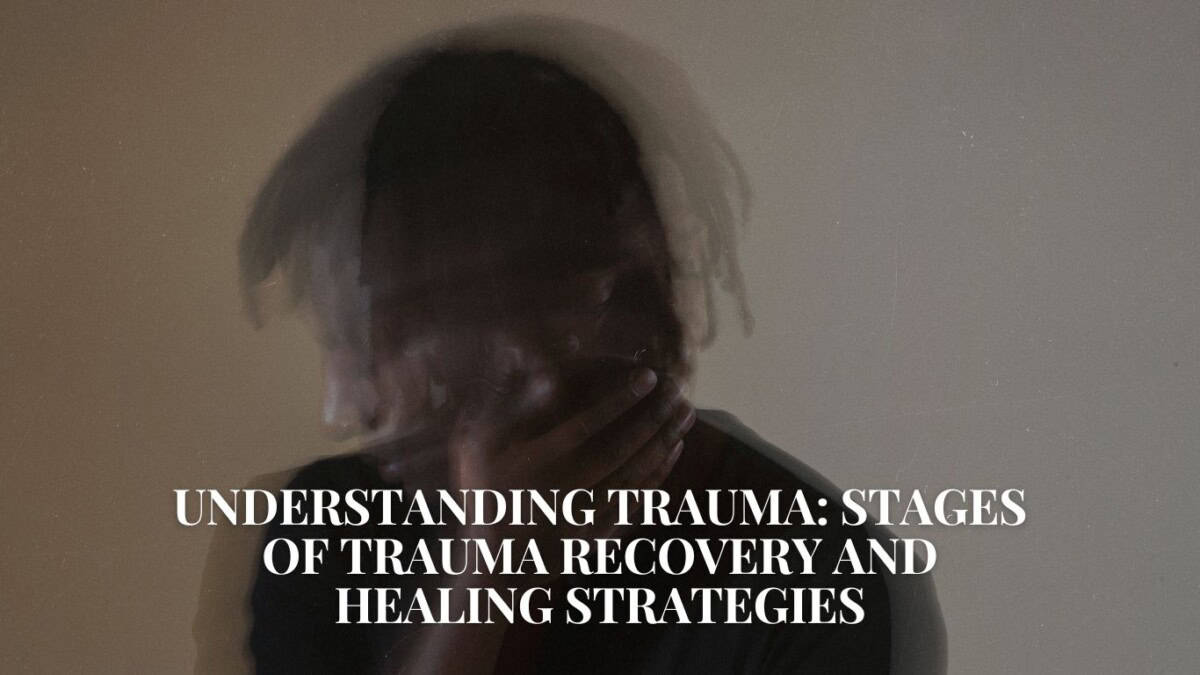Trauma often stays hidden, guiding people towards addiction without them knowing. This quiet cycle traps many. But is it inevitable? This key question leads us to understand overcoming trauma and beating addiction. By using kind methods and proven strategies, breaking free is possible.
Key Takeaways:
- Identifying trauma is the first essential step in healing.
- Trauma and addiction feed into each other, creating a loop.
- Finding the right trauma healing methods is crucial for lasting recovery.
- Therapies like CBT and EMDR can address both trauma and addiction1.
- Having a supportive network is vital for resilience and staying sober.
- Those with childhood trauma are more likely to face alcohol and substance issues2.
Understanding the Connection Between Trauma and Addiction
Studying how trauma leads to addiction is key for mental health and substance abuse experts. It helps them craft better help that tackles addiction’s root causes.
Defining Trauma and Its Impact on the Brain
Trauma triggers stress chemicals in the brain, causing lasting harm. It changes how we feel and think, making some turn to drugs for relief. The brain areas that control emotions and memory, like the amygdala and hippocampus, can get rewired after trauma3.
Statistics: The Link Between Adverse Childhood Experiences and Substance Abuse
Studies show a strong link between early bad experiences and later drug problems. Two-thirds of adults had at least one bad childhood experience. This often leads to a higher chance of addiction45. People with four or more traumatic events have a much higher risk of alcohol and drug issues4.
Routes From Trauma to Addiction: Self-Medication and Coping Mechanisms
Traumatized people may use drugs to try and feel better, dealing with anxiety, sadness, or unwanted memories5. But this search for relief can turn into a need. If trauma happens early or often, the risk of addiction goes up43. Experts stress the importance of help for those facing both trauma and addiction. They highlight the need for treatments that understand both issues4.
Understanding how trauma and addiction are linked is vital for treating substance use disorders. By including trauma-informed care, we can improve recovery chances and prevent relapse. This approach makes overcoming addiction with resilience against trauma a real possibility for the future5.
Recognizing the Different Forms of Trauma
Healing from trauma starts when we recognize its various forms. People face traumas like physical and sexual assault, domestic violence, emotional abuse, parental neglect, and bullying. Each type, from natural disasters to chronic illnesses, seriously affects our mental and physical health.
For kids, trauma is extra challenging. It can happen at a very young age, making those under 8 very vulnerable6. They may grow up with low self-esteem, risky habits, addiction, and deep feelings of shame and guilt6.
Sexual trauma can cause PTSD, with symptoms like nightmares, severe anxiety, and loss of memory6. The impact varies if the trauma was a one-time event or ongoing abuse6. It might even cause trouble during certain medical checks6.
Trauma from bad relationships can damage how we see ourselves. It harms our ability to have healthy future relationships6. The harm might not show right away but can change how we view ourselves and what we feel we deserve in partners over time6.
Trauma can also upset our core beliefs. Those hurt by manipulative or harmful religious settings often struggle emotionally and socially, finding it hard to bond with new, supportive groups6.
Early life trauma can lead to trouble managing emotions7. This often shows as extreme emotions or the opposite, where feelings don’t connect with thoughts or actions, known as numbing7.
It’s crucial to understand these trauma types for healing. Recognizing the specific traumas one has faced allows for the right therapeutic steps, helping recover and grow stronger.
Overcoming Trauma in Recovery: A Path to Resilience
Making it through the journey of overcoming trauma in recovery is key to building resilience. This is essential for lasting recovery from addiction. The American Psychological Association (APA) says resilience is learning to adapt well to stress. It’s a skill you can develop over time8.
For those who have faced trauma, resilience can mean discovering new strengths and ways to cope. It often leads to post-traumatic growth. This is when people go through huge personal changes, find better relationships, gain new outlooks on life, and feel stronger8.
Getting the right support is critical for this kind of growth. Joining support groups and seeing therapists who know about trauma can offer a safe place to heal. These experts often use proven methods like cognitive-behavioral therapy (CBT) and eye movement desensitization and reprocessing (EMDR) to help9.
- Building a set of resilience skills such as mindfulness, meditation, and exercise helps keep your mind and body healthy8.
- Finding purpose and meaning in life can shield you from trauma’s impact, reducing the risk of depression and PTSD8.
- Activities like journaling, creating art, and hobbies offer a way to let out feelings and start healing8.
The journey to resilience for those overcoming trauma includes therapy, self-care, and community support. This approach doesn’t just help in overcoming trauma in recovery. It also allows people to lead fulfilling lives, despite past challenges.
Identifying the Signs and Symptoms of Unresolved Trauma
Some signs might not show right away, making it essential to know both the physical and emotional ones.
Physical and Emotional Indicators of Traumatic Stress
Unresolved trauma can affect someone’s daily life in big ways. They might have high blood pressure, trouble sleeping, chronic headaches, or feel nauseated a lot. These physical issues often come with mental health problems like anxiety or depression10.
On the emotional side, a person might feel very sad, angry, or scared for a long time11. They might be overly alert, distrust others, feel detached, have control issues, low self-worth, or obsess over bodily feelings. All these are signs that someone needs help from a trauma therapist10.
Behavioral Clues Suggesting a Trauma-Addiction Cycle
People with trauma might avoid things that remind them of it or pull away from others. They might sleep or eat a lot more or less, use drugs or alcohol, hurt themselves, or be aggressive12. These actions might indicate they’re stuck in a cycle where they use substances to try to feel better but end up feeling worse12.
Spotting these behaviors is important for starting the right treatment and stopping the cycle. Getting the right help can lead to healing and getting back on track.
It’s crucial to understand these signs and get professional help. This is the first step to heal from trauma and to prevent more harm10.
The Critical Role of Dual Diagnosis in Addiction Treatment
In the world of addiction recovery, the importance of dual diagnosis can’t be ignored. It looks at both substance abuse and mental health issues like PTSD. These problems often go together and make each other worse. Dual diagnosis treatment works on both issues, helping people find a better path to recovery.
Understanding Dual Diagnosis: Substance Use and Mental Health
Statistics show that in the U.S., 29% to 59% of people with substance abuse issues also have mental health problems13. This high rate shows how common it is for these problems to occur together. Centers like Inner Voyage Recovery Center see that people often use drugs or alcohol to try to feel better from PTSD symptoms, like pain or anxiety14.
Tailoring Treatment to Address Both Trauma and Addiction
Treating dual diagnosis needs a special approach that deals with both trauma and addiction. Techniques such as Cognitive Behavioral Therapy (CBT) and Eye Movement Desensitization and Reprocessing (EMDR) are key. EMDR, for instance, helps decrease PTSD symptoms, reducing reliance on substances14. Also, joining recovery groups like Alcoholics Anonymous (AA) can really help. These groups improve well-being, ease stress, and help people keep their jobs, supporting lasting recovery13.
The success of dual diagnosis treatments depends on understanding the link between trauma and addiction. Knowing how they affect each other leads to better help and support. This improves the chances for people facing these tough issues. Places like Inner Voyage Recovery Center offer critical support, helping through emotional and psychological healing14.
Exploring Effective Trauma Therapy Options
As we learn more about trauma’s effects on mental health, the trauma therapy options we have expand. About 70% of U.S. adults have faced trauma at least once in their lives15. This shows how vital effective therapy choices are.
Cognitive-Behavioral Therapy (CBT) is known for its organized method, lasting 12 to 16 weeks16. It helps people deal with their thoughts and actions linked to trauma. The American Psychological Association highly recommends trauma-focused CBT. It typically involves 8 to 25 sessions based on what the person needs16.
Eye Movement Desensitization and Reprocessing (EMDR) is another crucial therapy. The APA gives it a positive nod for treating PTSD15. It can be quicker than other therapies. Studies indicate 80% to 90% of patients see big symptom reductions in three sessions15.
- Cognitive Processing Therapy (CPT) and Prolonged Exposure (PE) therapy, also strongly recommended for PTSD by the APA15, focus on cognitive and exposure techniques, respectively.
- Accelerated Resolution Therapy (ART) and Somatic Experiencing are recognized for their success in treating trauma-related issues15.
- Options like narrative therapy and hypnotherapy are also being looked at for their role in easing PTSD symptoms and boosting well-being15.
The number of trauma therapy options keeps growing. This gives people more ways to find healing and improve their mental health, tailored to their own needs.
Integrating Detox and Inpatient Care in Healing from Trauma
Healing from addiction and trauma involves many steps. It requires detailed medical help and kind, full care. Detox and inpatient care are key parts of healing. They ready people for a life without addiction and help heal trauma.
The Detox Process: Managing Withdrawal Safely
Starting recovery with professional detox is essential. It safely manages withdrawal symptoms. During detox, doctors help reduce the physical withdrawal symptoms. This keeps the person safe during this tough time. The support given then stabilizes patients mentally, readying them for further recovery steps. A closely watched detox has been proven to help greatly, especially with continuous care after detox improving treatment results significantly17. Programs like Assertive Continuing Care (ACC) also help keep teens off drugs after residential treatment.
The Benefits of Inpatient Treatment Centers for Comprehensive Care
After detox, inpatient treatment offers vital structured care. These places help people stay sober and deal with trauma’s psychological effects. They keep patients away from triggers, lowering relapse risks. Inpatient programs also use different therapies to address trauma and addiction’s root causes. This support helps patients gain strength and find better coping strategies.
Inpatient treatment boosts the success of long-term recovery plans. Studies show that adding inpatient care to outpatient treatment gets better results, like more sobriety and following through with aftercare plans17. Recovery Management Checkups in these programs help with long-term substance use management and make treatment more cost-effective17.
The blend of detox and inpatient care is vital for overcoming trauma and addiction. These treatments provide a safe space for withdrawal and a solid base for recovery. They tackle the physical and emotional issues people face while trying to take back control of their lives.
Building a Strong Support System for Long-Term Recovery
Building a solid network of support is key for those in recovery from addiction. This network brings a sense of community and improves chances of staying sober. In fact, people who go to support group meetings like Alcoholics Anonymous achieve a 75%18 success rate in remaining sober.
A strong support system offers more than friendship. It provides emotional and practical help during recovery. Research indicates that a solid support network increases success rates by 60%18. Being part of support groups also lowers stigma and helps prevent relapse19.
- Having positive relationships boosts the chances of staying sober long-term to 80%18.
- A good social network reduces the risk of falling back into old habits by 27%19.
- Family support is crucial, decreasing relapse risks by 40%18.
Support can range from formal meetings to hanging out casually, or even online chats, increasing emotional support by 30% for some18. Those who engage in these groups have a 76% higher likelihood of maintaining their sobriety19.
Keeping strong social ties is essential for preventing relapse. Science says building a circle of friends after treatment is crucial for continued success20. Setting goals and establishing routines within these networks boosts motivation and success rates20.
In sum, investing in a strong support system is crucial for recovery. Support networks offer vital encouragement and have been shown to significantly improve recovery results. This support is the backbone of effective, lasting recovery and trauma support.
Coping Strategies and Self-Care Techniques for Trauma Survivors
If you are healing from trauma, it’s crucial to use good coping strategies and self-care. Healing from trauma involves things like exercise, art, and regular self-care habits. These help build strength and happiness in your life.
Exercise and Movement: Physical Therapies for Healing
Exercise is key for those healing from trauma. It helps 81% of those with trauma feel better through movement21. Doing exercises makes you feel less stressed and improves your mood. Things like yoga, walking, or dancing can make you feel more balanced and less anxious.
Creative and Artistic Expression as a Tool for Emotional Release
Activities like painting, writing, or playing music can really help. They let 76% of people facing trauma to forget bad memories and feel positive21. These creative outlets are a safe way to share your feelings. They help you heal emotionally and understand yourself better.
Healthy Alternatives to Substance Use During Recovery
Finding healthy ways to heal, instead of using substances, is important. Things like meditation, deep breathing, and hobbies help most survivors. Meditation helps 68% of people feel less upset21. And, 77% sleep better by sticking to a bedtime routine21. These methods keep you stable and reduce the chance of depending on substances.
Knowing how these strategies and self-care can help in trauma recovery is key. They not only heal but also let survivors take back control. They encourage a hopeful and full life.
Conclusion
Starting a journey to a healthier life without addiction takes courage and a strong commitment to get over trauma. The recovery steps — Safety and Stabilization, Remembrance and Mourning, Reconnection and Integration — were first introduced by Dr. Pierre Janet and later expanded by Dr. Judith Herman. These steps provide a clear path to healing22. Though everyone’s journey is unique, focusing on the present rather than past hurts can greatly improve life quality22.
Looking at childhood traumas, the ACE Study shows us the impact they have. Treatments like Trauma-Focused Cognitive Behavioral Therapy (TF-CBT), Eye Movement Desensitization and Reprocessing (EMDR), and Dialectical Behavior Therapy (DBT) have helped many. They reduce symptoms of PTSD, depression, and anxiety, making people more resilient23. While revisiting traumatic memories is still debated, healing from trauma is acknowledged as a detailed process. It highlights the importance of starting healing early and having strong support2223.
Finally, lifelong recovery is definitely possible. It’s based on understanding trauma, picking the right therapies, and having a good support circle. With ongoing self-care and coping strategies, those healing from trauma can build a solid and joyful future. They move towards a life free from addiction, celebrating their resilience22.
FAQ
What are the common stages of trauma recovery?
The common stages of trauma recovery include: 1. Safety and Stabilization, where the focus is on establishing a sense of safety and control. 2. Remembrance and Mourning, where the individual processes and grieves the traumatic memories. 3. Reconnection and Integration, where the individual develops a new sense of self and engages in meaningful activities. These stages are not linear and individuals may move back and forth between them.
How can I heal from trauma?
To heal from trauma, it is important to seek professional help, such as therapy or online therapy. Engaging in self-care practices, building a strong support network, and developing coping skills are also crucial. Techniques like mindfulness, meditation, and exercise can aid in managing trauma symptoms. Remember, healing from trauma is a gradual process that requires patience and persistence.
What are the effects of trauma on mental health?
The effects of trauma on mental health can be profound and varied. Individuals may experience anxiety, depression, post-traumatic stress disorder (PTSD), and other emotional disturbances. Trauma can also affect cognitive functions, such as memory and concentration, and lead to physical symptoms like headaches or gastrointestinal issues. The effects of trauma can be long-lasting but can be managed with appropriate treatment and support.
What is PTSD and how is it related to trauma?
Post-traumatic stress disorder (PTSD) is a mental health condition triggered by experiencing or witnessing a traumatic event. Symptoms include flashbacks, nightmares, severe anxiety, and uncontrollable thoughts about the event. Not everyone who experiences trauma
Source Links
- What Most People Don’t Know About Trauma and Addiction – https://www.psychologytoday.com/us/blog/relationship-and-trauma-insights/202007/what-most-people-dont-know-about-trauma-and-addiction
- Understanding Trauma and Addiction – Green Hill Recovery – https://greenhillrecovery.com/understanding-trauma-and-addiction/
- Exploring the Link Between Trauma and Addiction: Understanding the Connection | The Nestled Recovery Center – https://thenestledrecovery.com/rehab-blog/link-between-trauma-and-addiction/
- Understanding the Connection Between Trauma and Substance Abuse – https://www.verywellmind.com/connection-trauma-and-substance-abuse-7269368
- Understanding the Connection Between Trauma and Addiction – https://addictionrehabtoronto.ca/understanding-the-connection-between-trauma-and-addiction-a-path-to-recovery/
- Types of Trauma & How to Heal – https://health.clevelandclinic.org/how-to-heal-from-trauma
- Understanding the Impact of Trauma – Trauma-Informed Care in Behavioral Health Services – https://www.ncbi.nlm.nih.gov/books/NBK207191/
- Trauma Resilience & How To Build It | Charlie Health – https://www.charliehealth.com/post/trauma-resilience-what-it-is-and-how-to-build-it
- Navigating Trauma and Recovery – https://firstlightrecovery.com/trauma-and-recovery/
- What Is Unresolved Trauma? – https://www.verywellmind.com/unresolved-trauma-symptoms-causes-diagnosis-and-treatment-6753365
- Emotional and Psychological Trauma – HelpGuide.org – https://www.helpguide.org/mental-health/ptsd-trauma/coping-with-emotional-and-psychological-trauma
- Signs of Emotional Trauma in Adults: Recognizing and Addressing the Symptoms | All Points North – https://apn.com/resources/signs-of-emotional-trauma-in-adults-recognizing-and-addressing-the-symptoms/
- Support, Mutual Aid and Recovery from Dual Diagnosis – https://www.ncbi.nlm.nih.gov/pmc/articles/PMC1868661/
- Dual Diagnosis Treatment for Substance Use and PTSD – https://innervoyagerecovery.com/2024/05/dual-diagnosis-for-sud-and-ptsd/
- Best Types of Therapy for Trauma: PTSD, Childhood Trauma, and More – https://psychcentral.com/health/best-types-of-therapy-for-trauma
- 5 Effective Trauma Therapy Methods – Restorative Counseling – https://rcchicago.org/5-effective-trauma-therapy-methods/
- Impact of Continuing Care on Recovery From Substance Use Disorder – https://www.ncbi.nlm.nih.gov/pmc/articles/PMC7813220/
- Developing A Support System | Anchored Tides Recovery – https://anchoredtidesrecovery.com/developing-a-support-system/
- How to Build a Sober Support Network – https://www.bluecrestrc.com/how-to-build-a-sober-support-network/
- Rebuilding Your Life: Crafting a New Normal After Addicti… – https://wishrehab.com/blog/building-a-strong-foundation-the-power-of-structure-and-routine-in-recovery
- VA.gov | Veterans Affairs – https://www.ptsd.va.gov/gethelp/coping_stress_reactions.asp
- Phases of Trauma Recovery – Trauma Informed – https://trauma-informed.ca/recovery/phases-of-trauma-recovery/
- Navigating Childhood Trauma and Recovery: Types, Effects, and Evidence-Based Approaches — Anesis Therapy – https://anesistherapycenter.com/blog/2023/5/8/navigating-childhood-trauma-and-recovery-types-effects-and-evidence-based-approaches
Katie is a Licensed Clinical Social Worker who has worked as a primary therapist, supervisor, and now clinical director for SUD/MH treatment centers for the past 12 years. Katie is trained in Brainspotting, EMDR, Internal Family Systems and Dialectical Behavior Therapy and is passionate about treating substance use disorders, trauma and grief.






